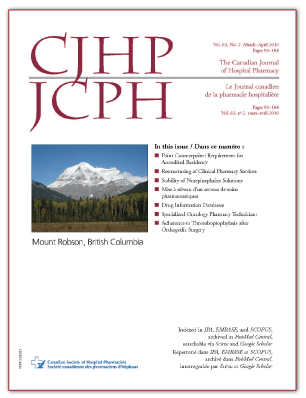Care Providers’ Satisfaction with Restructured Clinical Pharmacy Services in a Tertiary Care Teaching Hospital
DOI:
https://doi.org/10.4212/cjhp.v63i2.893Keywords:
clinical pharmacy, restructuring, tertiary care hospital, evidence-based, practice delivery, pharmacie clinique, restructuration, hôpital de soins tertiaires, données probantes, prestation de servicesAbstract
ABSTRACT
Background: At the time this study was undertaken, clinical pharmacy services at the authors’ institution, a tertiary care teaching hospital, were largely reactive in nature, with patients and units receiving inconsistent coverage.
Objective: To develop an evidence-based model of proactive practice and to evaluate the satisfaction of pharmacists and other stakeholders after restructuring of clinical pharmacy services.
Methods: The literature was reviewed to determine a core set of pharmacist services associated with the greatest beneficial impact on patients’ health. On the basis of established staffing levels, the work schedule was modified, and pharmacists were assigned to a limited number of patient care teams to proactively and consistently provide these core services. Other patient care teams continued to receive reactive troubleshooting-based services, as directed by staff in the pharmacy dispensary. A satisfaction survey was distributed to all pharmacists, nurses, and physicians 18 months after the restructuring.
Results: Of the 26 pharmacists who responded to the survey, all agreed or strongly agreed that the restructuring of services had improved job satisfaction and patient safety and that other health care professionals valued their contribution to patient care. Nurses and physicians from units where pharmacists had been assigned to provide proactive services perceived pharmacist services more favourably than those from units where pharmacist services were reactive. Pharmacists, nurses, and physicians all felt that proactive pharmacist services should be more widely available. Challenges reported by pharmacists included increased expectations for documentation and guilt about “cutting back” services where they had previously been provided.
Conclusions: Restructuring clinical pharmacy services in an evidencebased manner improved pharmacists’ satisfaction and created demand from other stakeholders to provide this level of service for all patients.
RÉSUMÉ
Contexte : Au moment où cette étude a été menée, les services de pharmacie clinique à l’établissement des auteurs, un hôpital universitaire de soins tertiaires, étaient en grande partie de nature réactive, les patients et les unités recevant des services inégaux.
Objectif : Créer un modèle de pratique proactive, fondé sur des données probantes, et évaluer la satisfaction des pharmaciens et des autres parties prenantes après la restructuration des services de pharmacie clinique.
Méthodes : On a effectué une revue de la littérature pour déterminer une série de services de pharmacie de base associés aux plus importantes répercussions bénéfiques sur la santé des patients. À partir des niveaux d’effectifs établis, l’horaire de travail a été modifié, et les pharmaciens ont été assignés à un nombre limité d’équipes de soins aux patients pour assurer de façon proactive et constante ces services de base. D’autres équipes ont continué à recevoir des services de dépannage de nature réactive, aiguillés par le personnel à la pharmacie. Un sondage sur la satisfaction a été distribué à tous les pharmaciens, médecins, infirmières et infirmiers, 18 mois après la restructuration.
Résultats : Des 26 pharmaciens ayant répondu au sondage, tous étaient d’accord ou tout à fait d’accord pour dire que la restructuration des services avait amélioré la satisfaction au travail et la sécurité des patients et que les autres professionnels de la santé reconnaissaient leur contribution aux soins aux patients. Le personnel infirmier et les médecins des unités où les pharmaciens avaient été assignés pour fournir des services de nature proactive avaient une perception plus favorable de leurs services que ceux des unités retenues pour y fournir des services de nature réactive. Les pharmaciens, le personnel infirmier et les médecins ont tous estimé que les services pharmaceutiques proactifs devraient être offerts à plus grande échelle. Les défis soulignés par les pharmaciens incluaient des attentes plus élevées en matière de consignation et le fait de se sentir coupables de « couper » des services auparavant offerts.
Conclusions : La restructuration des services de pharmacie clinique fondée sur des données probantes a amélioré la satisfaction des pharmaciens et créé une demande de la part des autres parties prenantes pour la prestation de ce niveau de services pour tous les patients.
Downloads
Downloads
Issue
Section
License
Copyright © Canadian Society of Healthcare-Systems Pharmacy.
After publication of a manuscript in the CJHP, the authors of the manuscript must obtain written permission from the CSHP (publications@cshp.ca) before reproducing any text, figures, tables, or illustrations from the work in future works of their own. If a submitted manuscript is declined for publication in the CJHP, all said rights shall revert to the authors. Please note that any forms (e.g., preprinted orders and patient intake forms) used by a specific hospital or other health care facility and included as illustrative material with a manuscript are exempt from this copyright transfer. The CJHP will require a letter from the hospital or health care facility granting permission to publish the document(s).










